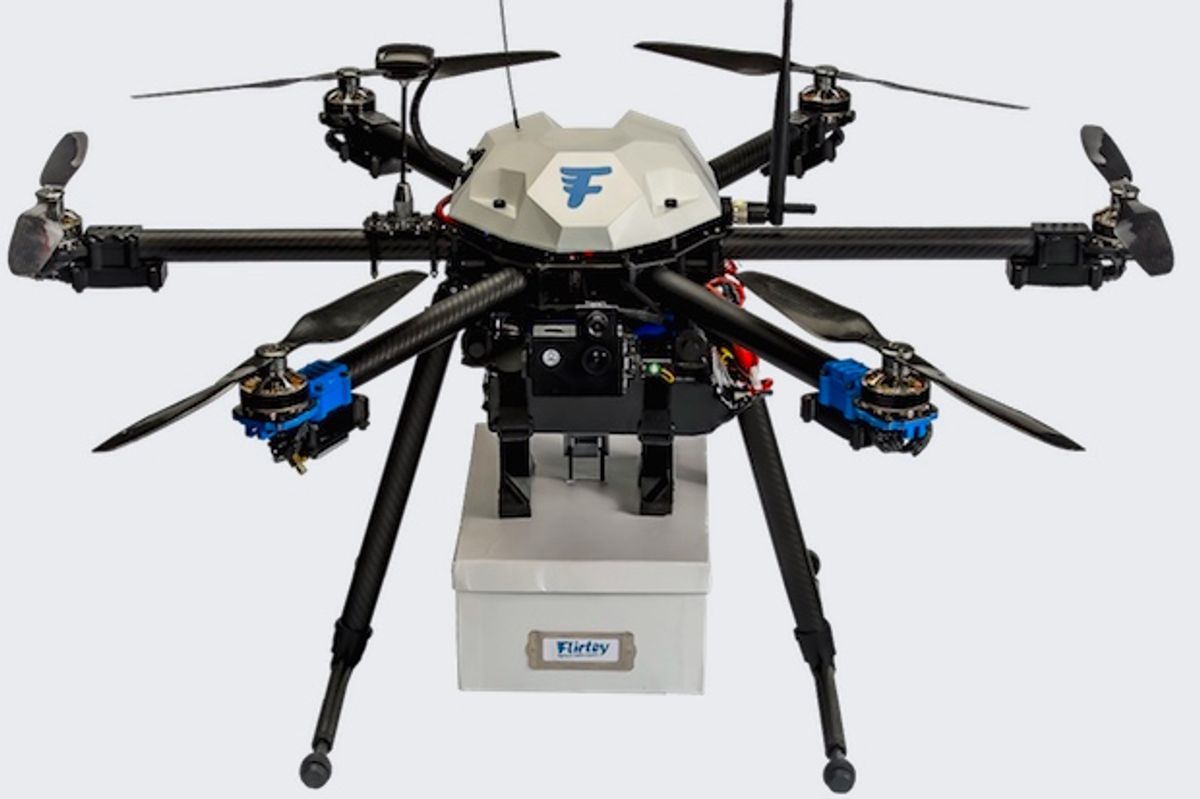Flirtey is a company that’s working to commercialize the consumer delivery drone, which is something that we’ve been very, very skeptical about. On Friday, Flirtey partnered with Virginia Tech and the U.S. Federal Aviation Administration to conduct the very first officially-approved drone delivery in the United States. Flirtey called it a “Kitty Hawk moment” for the entire delivery drone industry, but we’re not so sure.
Once a year, there’s a free rural health clinic in Wise, Va. The clinic tries to plan ahead by bringing all the medication along that it’ll need for the whole day, but if they run out of anything, the supplying pharmacy is an impractical 90-minute drive away. This year, NASA Langley provided a semi-autonomous (remotely piloted) Cirrus SR-22 light aircraft to shuttle meds most of the distance (local airport to local airport), and then Flirtey’s pixhawk-powered hexacopter filled in for the final local airport to health clinic run, a distance of about a mile:
“This is a Kitty Hawk moment not just for Flirtey, but for the entire industry,” said Flirtey Chief Executive Officer Matt Sweeny. “Proving that unmanned aircraft can deliver lifesaving medicines is an important step toward a future where unmanned aircraft make routine autonomous deliveries of your everyday purchases.”
We can’t fault Flirtey for being excited to pull this off, but it’s important to take this delivery in context, and we don’t think that that context is a “Kitty Hawk moment.” The reason this works right now isn’t just that it was approved by the FAA, which would suggest that drone deliveries are ready to go except for regulatory approval: it’s more that this delivery took place in as close to a structured environment as is possible outdoors. In other words, there’s a predefined launch point, a predefined landing point, a carefully thought out route that avoids things like trees and power lines, and a surety that there won’t be any thing else flying in the area. Flirtey’s drone doesn’t have to have to do any sort of active sense and avoid, so as far as we know, really it’s just GPS waypoint following with a payload. It’s great that they made it work, but it’s not a demonstration of any specific technology that will bring delivery drones any closer to realistic usefulness: it’s simply a drone navigating autonomously from GPS waypoint to GPS waypoint.

I’m also not sold on the practicality of the whole “skycrane” idea. I get that you want to keep your dangerous and expensive drone as far away from any unsecured location on the ground as possible, but in my opinion, this is trying to solve a problem that should instead just be avoided completely. Based on all of these reasons that we discussed a year and a half ago why consumer delivery drones aren’t going to work anytime soon (none of which have been solved, or even mitigated very much), I just don’t see this demo as that much of a game changer. As far as I can tell, it doesn’t do anything to further the cause of consumer delivery drones at all.
So, forget consumer delivery drones. Just because it may eventually be technologically possible to deliver online retail items or fast food to consumers with autonomous drones doesn’t mean that it makes sense to do so (commercially or otherwise), now or ever. But there are all kinds of situations in which delivery drones really can be valuable, and delivering medicine is one of those. DHL had the right idea when they demonstrated a drone delivery service that can deliver urgently needed goods to thinly populated or remote areas or in emergencies, and we’re excited to see more of that.
Flirtey’s demo was a good start, but if there’s going to be a “Kitty Hawk moment” for delivery drones, it’ll be in some situation where you don’t have the option of just driving for 5 minutes instead. It’ll be a situation where a delivery drone is the only option, an opportunity to show that rather than just making something more convenient, drones can make something happen that would otherwise be impossible with any other technology.
[ Flirtey ] via [ Roanoke Star ]
Evan Ackerman is a senior editor at IEEE Spectrum. Since 2007, he has written over 6,000 articles on robotics and technology. He has a degree in Martian geology and is excellent at playing bagpipes.



